THE FIVE SPECIES OF ALASKAN SALMON
Here you will find a combination of information, a description of all five species of salmon, and at the end of each short explanation when we fish for this type of salmon. We fish for all species of salmon except Sockeye. You can find halibut information here.
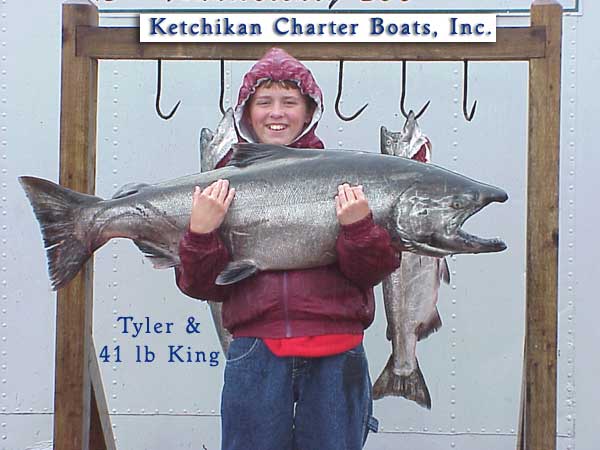
#1 King Salmon!
Chinook: Oncorhynchus tshawytscha
Also known as the Chinook salmon. The name Chinook came from the native Columbia River people. The name is considered a proper and thus is always capitalized.
The name King Salmon came from there size here in Alaska! They are the largest of the five species. They are most elusive of the Salmon types to catch while out fishing we take great care to present the bait to King Salmon.
When in the ocean they have blue-green backs and silver sides with irregular spotting on the back, & fins, and both lobes of the tail. Another distinguishing characteristic is their black gum line.
Spawning colors are olive-brown to dark brown. Males also develop a hooked snout. These fish live about 3-6 years. We are usually able to keep these if they are 28 inches in length, and over. Avg. Size 25-50 lbs. Trophy size 60 pounds.
We target this species! from mid-May to mid-July
These make excellent candied smoked Salmon!
#2 Pink Salmon
Pink: Oncorhynchus gorbuscha
Also known as humpies, due to the huge hump males get just behind the head, during the spawning phase. Although they are the smallest of the species, they are the most abundant in number. They spend the least amount of time in freshwater, spawning in two-year cycles very close to the mouth of streams with little to no upstream migration. While in the ocean they appear to have steel blue to blue-green backs, silversides, and a white belly with large oval spots covering their back. During the spawning phase, pinks have dark backs with pinkish and green spots on their sides. These fish generally live for two years, and they average in size 4-7 lbs. Trophy size 10 Pounds.
We target this species from July to August!
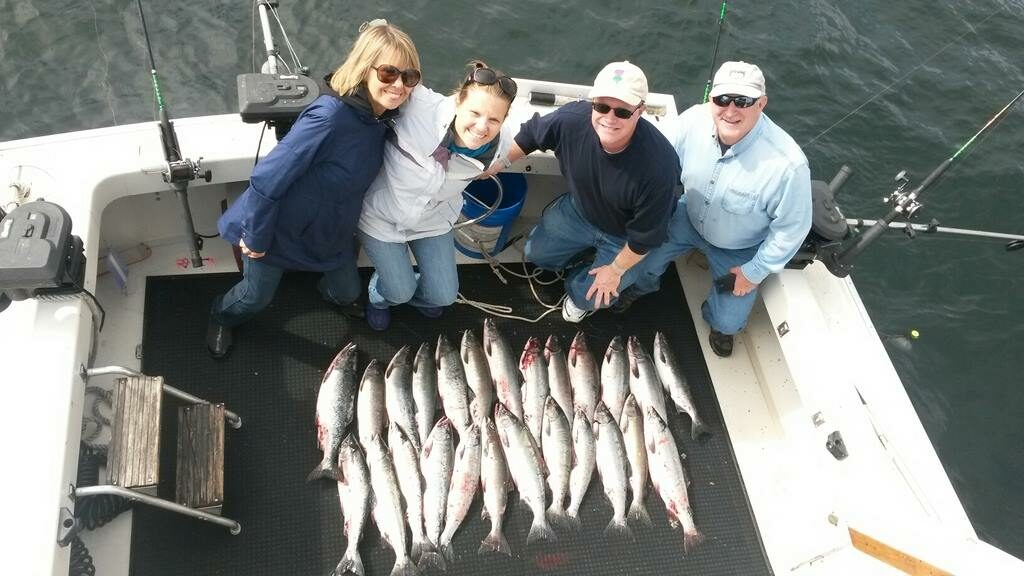
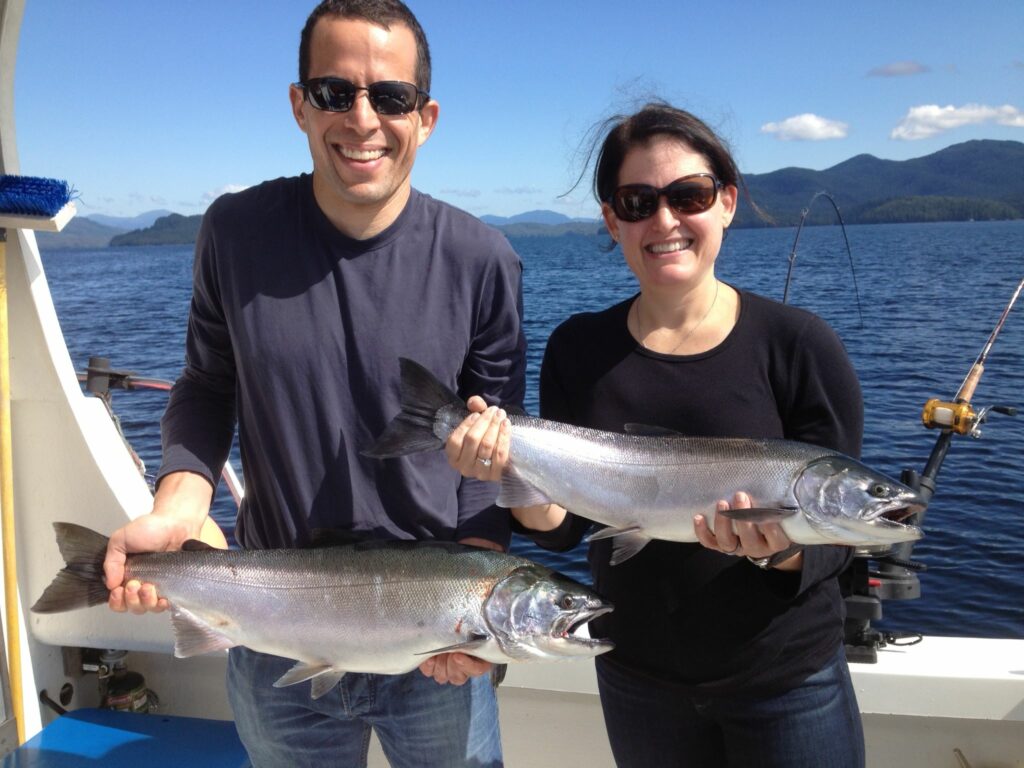
#3 Silver salmon
Coho: Oncorhynchus kisutch
Also known as Coho Salmon, they are the second least abundant (following King Salmon). They spend 1-2 years in freshwater and prefer near-shore feeding grounds. Silver’s usually traveling less than 100 miles from the mouth of their stream for reproduction. While in the ocean they have dark metallic blue-greenish backs with silver sides and a light belly. They have small black spots on their backs and the upper lobe of the tail.
Spawning silver salmon develop a deep reddish or maroon coloration that covers their entire body – head and tail included. Ocean adults and spawning-phase silvers have small black spots that run along the back and on the upper lobe of the tail. Also, they have a dark gray or blackish mouth with a white gum-line. These fish generally live 3-5 years.
Avg. Size 12-15 lbs. Trophy size 18 Pounds.
We target this species in Late June to September!
CAPTAIN DAN’S GUESTS 22 POUND CHUM SALMON!
# 4 Chum Salmon
Chum: Oncorhynchus keta
BIGGEST CHUM EVER CAUGHT OR SEEN
BY DAN IN HIS WHOLE CAREER!
We catch these every once in a while.
We do not target this species!
Chum Salmon, dog or calico salmon are the second-largest salmon (following King Salmon). They like the Pink Salmon reproduce near the mouth of their stream. When in the ocean they are metallic, green-blue color along the back with black speckles that closely resemble sockeye and coho. While spawning and ocean phase chums have a white mouth with a white gum-line., males get vertical bars in reds, greens, and purples, while females get black horizontal stripes. These fish generally live 3-5 years, are 21-31in in length. Chum salmon can weigh anywhere from 8-15 lbs. (3.6 to 6.8 kg} but can weigh up to 45 lbs. ( 20 kg).
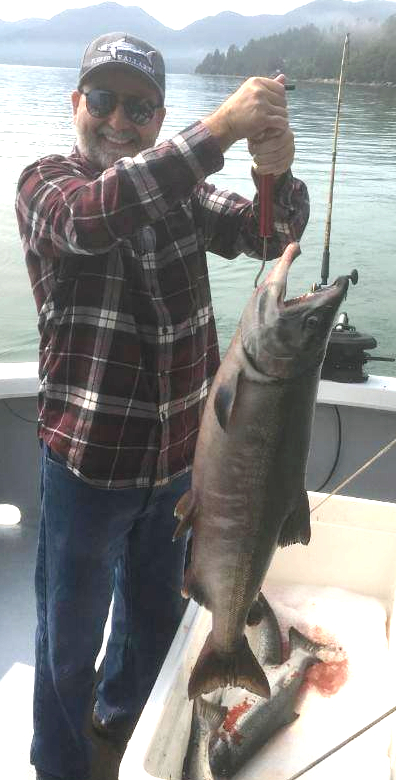
Chum salmon are not as abundant but are caught in
(June, July, August)
SOCKEYE
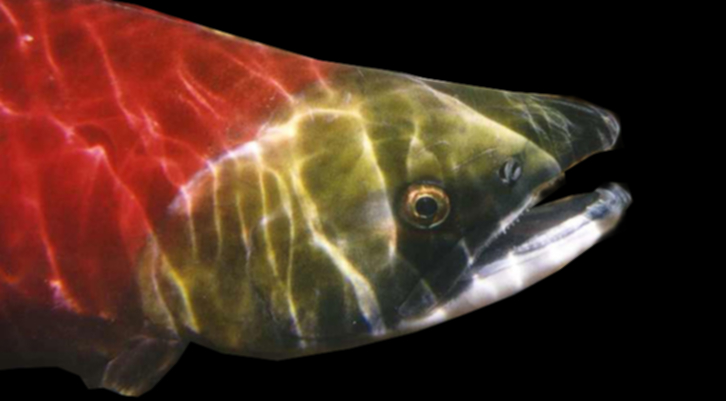
#5 Sockeye Salmon
Sockeye: Oncorhynchus nerka
Also known as Red salmon, Blueback salmon, Sockeye Salmon are the most economically essential types of salmon in Alaska. More pink and chum salmon get caught by commercial fishing vessels, but Sockeye Salmon is a higher class fish and sells for a much higher price. More than half of the Sockeye Salmon is frozen and sent to markets in the U.S. and Japan. Salted and packaged sockeye eggs (roe) are very precious in Japan. Sockeye salmon are anadromous fish, which means they can live in both fresh and saltwater.
With a deep, natural color, Sockeye is lower in fat but still high overall, allowing the flavor to better tastier. Many salmon lovers, including me, consider this the best salmon-eating experience!
The world record for Sockeye Salmon is 12 pounds, 4 ounces landed on the Kenai Riverbank in Alaska.
They range in size from 24 to 33 inches in length and weigh between 5 and 15 pounds.
We do not target this species.
Why Sockeye Salmon create such an angling dilemma? Lies in knowing a little about their life in the ocean. Unlike their cousins the silver, or king salmon, Sockeye is not known to be big on baitfish. Instead, they seem to feed primarily on zooplankton and crustaceans and thus do not develop a chase and kill mentality. Therefore, unlike the other salmon, they are not irritated by flashy green, orange, and silver lures. Many experienced Sockeye fishers insist that these fish bite rarely, if at all. There is, however, a highly successful method for catching reds, but a distinct set of conditions must exist.
We do not target this species!
